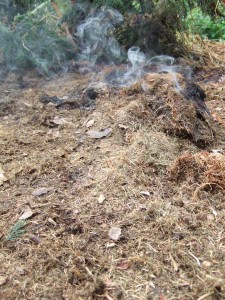Climate and land – how gardeners may affect climate
The three main greenhouse gases produced by unsustainable land use are:
- carbon dioxide;
- methane;
- and nitrous oxide.
Black carbon, or soot, although it is not a gas, can also be caused by unsustainable land use, behave like a greenhouse gas, and contribute to climate change.
Carbon dioxide, CO2, is a natural part of the carbon cycle, but human land uses often add more, especially from habitat destruction and the cultivation of soil. When we turn woodlands, wetlands, and other natural habitats into pasture, arable fields, buildings and roads, or when we plough or dig the soil, the carbon held in the soil and vegetation becomes extra carbon dioxide and methane to trap more heat in the atmosphere.
Here are some of the ways in which we gardeners may cause extra carbon dioxide to be added to the atmosphere:
- using peat or potting compost containing peat, so that the carbon stored in peatland is oxidised;
- buying garden furniture or other wooden products made from woodland which has been destroyed rather than taken as a renewable crop from sustainably managed woodland;
- digging soil and leaving it bare so that the carbon in soil organic matter is oxidised;
- using power tools which burn fossil fuel, either directly as petrol, or indirectly as electricity generated by burning fossil fuel;
- using patio heaters;
- heating greenhouses;
- burning garden prunings and weeds on a bonfire;
- buying tools, synthetic nitrogen fertilizers, pesticides and other materials which have been manufactured using fossil fuel;
- heating and treating swimming pools by burning fossil fuel;
- watering our gardens with tapwater, which has been treated and pumped by burning fossil fuel (according to a 2009 report for the Environment Agency and Energy Saving Trust tapwater has a greenhouse gas impact of about 1kg CO2 per m3);
- buying garden products imported from far away;
- driving long distances to visit gardens or to buy garden products.
Methane, CH4, is also a natural part of the carbon cycle, but human land uses often add more, especially from anaerobic soil, artificial wetlands such as rice fields, and from the guts of farm animals, especially ruminants such as cattle and sheep.
We may cause extra methane to be added to the atmosphere in several ways:
- compacting soil so that it becomes anaerobic, for example by treading on soil when it’s wet;
- allowing compost heaps to become compacted and anaerobic;
- allowing ponds to become anaerobic, for example by adding unsuitable fish species which stir up sediment that shades out and kills oxygenating plants, or by failing to add oxygenating plants in the first place;
- creating homemade liquid feed by putting the leaves of plants such as comfrey underwater, or killing pernicious weeds by covering them with water, with the unintended consequence that the plants may release methane as they decay.
Nitrous oxide, N2O, is a natural part of the nitrogen cycle, but human land uses often add more.
Gardeners may cause extra nitrous oxide to be added to the atmosphere:
- using synthetic nitrogen fertilizer, for example ‘weed and feed’ on lawns, or even organic manures that are rich in nitrogen such as farmyard manure, especially when plants are not actively growing, so that some of that fertilizer may be oxidized to nitrous oxide.
Black carbon is not a gas, but it acts like one, because it can be suspended in the atmosphere and absorb heat.
We gardeners may easily cause extra black carbon to be added to the atmosphere:
- burning our ‘waste’ on bonfires;
- burning food on barbecues;
- making large heaps of soft compostable material such as grass cuttings which then catch fire.
Many of us have pyromaniac tendencies, but if we want to protect the climate we need to cut down on our bonfire habit, because burning garden prunings and weeds, especially if they’re wet, will turn them into soot as well as carbon dioxide. And of course if we buy anything transported by diesel-powered lorries then there will be black carbon emissions from the exhaust.
For anybody who wants to find out more, there’s excellent information on land use and climate change in Britain available from Farming Futures. On a worldwide scale, the Worldwatch document ‘Mitigating climate change through food and land use‘ is good on both good and bad farming.

